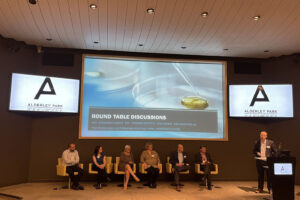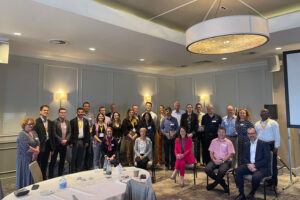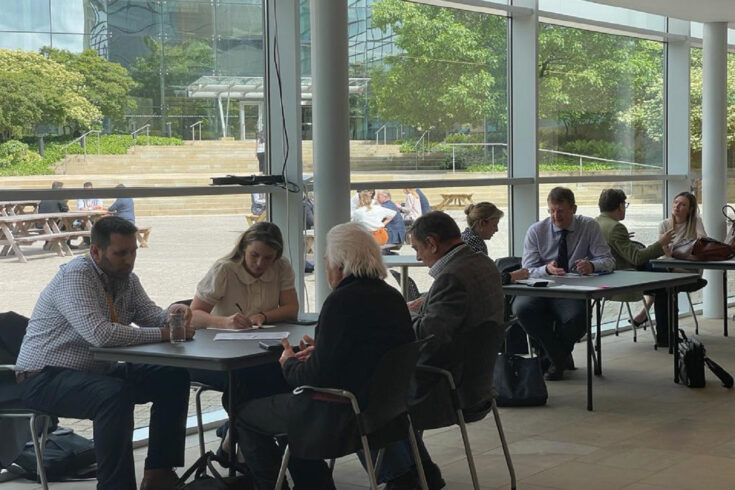The main aim was to boost collaboration and joint innovation between UK and non-UK organisations to help address the global issue of antimicrobial resistance (AMR), the slow pandemic. Read on to find out how this inward mission went…
What is an ‘inward’ mission?
Traditionally Innovate UK runs a variety of programmes to support global innovation which can be:
- Global Expert Missions (GEMs) where thematic experts from the UK visit countries across the globe to promote the UK’s talent and capabilities and make us the international partner of choice for collaboration
- Global Business Innovation Programmes (GBIPs) that support innovative businesses to explore and exploit a specific international business market
- other mechanisms delivered through the Innovate UK Global team.
Although much previous success has been realised, these are slow, one-target approaches that involve numerous planning stages to simply reach out to a single nation, but why not reverse this process and make the rest of the world come to us?
This is what the health and life sciences team, global team, Innovate UK EDGE, AMR Insights and local partners came together to accomplish with the AMR inward mission.
The inward mission was a unique opportunity for organisations around the world to visit AMR hotspots in the UK over the course of a week and to meet with others working in this field. An interesting and intensive programme of networking, matchmaking and showcasing events took place which allowed overseas delegates to get an insight into the UK’s AMR ecosystem.
The week initiated many collaborations between the UK and overseas delegates across diagnostics, antimicrobials and preventative markets. We hope the connections will help find solutions to the AMR problem and generate innovation and commercial opportunities further down the line.
First stop: Harwell Science and Innovation Campus (Oxford)
What better way to start a week designed to showcase UK capabilities, than going inside a giant microscope powered by lasers and electrons? This is what delegates got to enjoy on their first day during a visit to the Diamond Light Source, the UK’s national synchrotron facility. Sadly, no, we didn’t get to watch electrons shooting off at speeds close to the speed of light.
In reality, the electrons are stored safely inside pipes known as ‘beamlines’, in which they are directed at samples inside instruments at the end of each beam. What we did get to experience was how this technology can be utilised to curb AMR. Through studying samples using equipment that is 10,000 times more powerful than the microscopes found in traditional labs.
The day started, however, with a range of talks from organisations such as BactiVac, Evotec and Destiny Pharma, all of which are tackling aspects of AMR in their own way. From vaccines to antibacterials, they stressed the need for a multi-pronged approach to beat AMR. And of course, there was an all-important networking afternoon, when international organisations got to connect with local businesses and start their collaborative journey.
Next up: Alderley Park biotech and life sciences cluster (Manchester)
The next day, Alderley Park welcomed us to their scenic campus, which was surrounded by sheep mothering their new-born lambs. The delegation was amazed with the beautiful countryside so close to the state-of-the-art biotech facilities, where world-leading science and innovation is taking place.
The day followed a similar format to the previous day. We started with highlights of the work combating AMR being done in the region with a keynote from iiCON, a world leading programme for anti-infection innovation and research and development.

Panel discussion on stage at Alderley Park conference room.
Credit: Innovate UK
The morning was followed by a networking afternoon for more one to one conversations and a dinner to continue the discussions into the evening. Our delegates loved the park so much they were even asking if there were opportunities for international companies to set up UK hubs!
Now we’re getting towards the end of our journey, but even multiple train cancellations on our final (and longest!) leg of the journey up to Edinburgh were not going to dampen our spirits. Already great connections have been made, but the group was still excited to experience what Edinburgh had to offer!
Final destination: Edinburgh Biosciences cluster
After the long train journey, we arrived in Edinburgh and ‘golden hour’ made every iconic building look even more beautiful than usual. As someone who had previously only experienced grey cloudy Scotland, I was amazed our international friends got to see the city in such great weather.
After a lovely dinner and some Scottish whisky we all got a good night’s rest, ready to meet with even more potential collaborators the final day of our inward mission.

Group photo of all participants that attended the day in Edinburgh.
Credit: Bita Najafi, Innovate UK EDGE
Our week ended in style at the Hilton Carlton Hotel, where we got to hear all about the business opportunities in Scotland through Scottish Enterprise. More discussions followed on how organisations can come together to develop the novel antimicrobial therapies we so desperately need.
One talk in particular, from the founder of Novabiotics Ltd, (Dr Deborah O’Neil PhD OBE FRSE), gave everyone hope that the race against AMR is not yet lost, thanks Deborah! And of course, the group took the opportunity to connect and network, this time with Scottish organisations.
In(ward) or out(ward)?
It was interesting to be involved in the trialling of this twist on how missions are undertaken. The inward mission provided insight into which countries show enthusiasm and willingness to collaborate with the UK, as well as other nations, to tackle AMR challenges. Not only this, but it has also kickstarted engagement and positive conversations with multiple countries at once.
We will be gathering further information on how delegates found the mission and their key take-aways from this visit to the UK. Hopefully we can continue to support further discussions and ensure this leads to meaningful impact and partnering within the AMR space. Combined with outward missions, the UK could be set for real successful collaborations with the rest of the world.
Aside from the achievement of trialling this new mission model, the highlights of the week for me were hearing all the interesting conversations the delegates were having in their one to one networking sessions. Who would have thought that the CEO of a veterinary medicines company would find common ground and space for collaboration with a software company working on antimicrobial stewardship?
It just goes to show that tackling AMR is not only a global issue but one in which there is a need to bring in and connect to a whole range of disciplines in order to find the solutions we so desperately need.
Top image: Participants networking sat down at tables. Credit: Innovate UK



